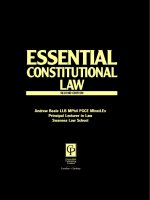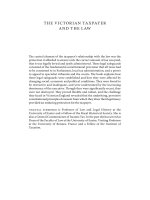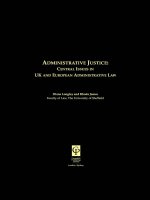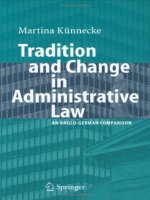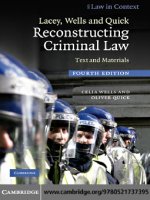CONSTITUTIONAL AND ADMINISTRATIVE LAW Fourth Edition pot
Bạn đang xem bản rút gọn của tài liệu. Xem và tải ngay bản đầy đủ của tài liệu tại đây (3.73 MB, 1,117 trang )
CONSTITUTIONAL AND
ADMINISTRATIVE LAW
Fourth Edition
Cavendish
Publishing
Limited
C
P
London • Sydney
This book is supported by a Companion Website,
created to keep Constitutional & Administrative Law
up to date and to provide enhanced resources for
both students and lecturers.
Key features include:
◆ termly updates
◆ self-assessment tests
◆ links to useful websites
◆ links to ‘ebooks’ for introductory and further reading
◆ revision guidance
◆ guidelines on answering questions
◆ ‘ask the author’ – your questions answered
Visit
www.cavendishpublishing.com/constandadmin
CONSTITUTIONAL AND
ADMINISTRATIVE LAW
Fourth Edition
Hilaire Barnett, BA, LLM
Queen Mary, University of London
Cavendish
Publishing
Limited
C
P
London • Sydney
Fourth edition first published in Great Britain 2002 by Cavendish Publishing
Limited, The Glass House, Wharton Street, London WC1X 9PX, United
Kingdom
Telephone: + 44 (0)20 7278 8000 Facsimile: + 44 (0)20 7278 8080
Email:
Website: www.cavendishpublishing.com
© Barnett, H 2002
First edition 1995
Second edition 1998
Third edition 2000
Fourth edition 2002
All rights reserved. No part of this publication may be reproduced, stored in a
retrieval system, or transmitted, in any form or by any means, electronic,
mechanical, photocopying, recording, scanning or otherwise, except under the
terms of the Copyrights Designs and Patents Act 1988 or under the terms of a
licence issued by the Copyright Licensing Agency, 90 Tottenham Court Road,
London W1P 9HE, UK, without the prior permission in writing of the
publisher.
Cataloguing in Publication details for this title are available from the British
Library
ISBN 1 85941 721 3
Printed and bound in Great Britain
For Matthew
The United Kingdom’s constitution, while of ancient origins, remains both
dynamic and vibrant. As every public lawyer is only too aware, nowadays,
the proper boundaries of constitutional and administrative law are both
increasingly wide and subject to debate. In compiling any textbook on this
subject, one of the principal preliminary tasks lies in defining the scope of
material to be included and the approach to be adopted in relation to that
material. The task of writing is made more problematic by the many and
varied depths in which, and the means by which, the subject is taught both in
the United Kingdom and overseas. Full time students; part time students;
students on long distance learning programmes such as the University of
London’s Programme for External Students and students combining both
constitutional and administrative law within a one year course, all have
differing needs. The aim in this book has been to provide sufficient detail to
meet all such needs in a user-friendly manner.
As emphasised in the introductory chapters, the study of the United
Kingdom’s constitutional and administrative law involves rather more than a
learning of rules of law, and necessarily encompasses – over and above an
understanding of legal rules – an understanding of history, government,
politics and conventional practices which form the foundations of the
contemporary constitution. As a result, any constitutional and administrative
law textbook must incorporate sufficient information relating to such matters
so as to enable students to view the constitution in its historical, political and
conventional context. In this work, I have addressed the subject in this manner
in order to provide a rounded, contextual explanation of the United
Kingdom’s constitution, which goes beyond pure law while also adequately
covering the law.
As previously, the text is divided into seven main parts. Part I provides a
general introduction to the scope of constitutional law, the sources of the
constitution and the structure of the United Kingdom. In Part II, the
fundamental concepts of the constitution are considered: the rule of law,
separation of powers, the royal prerogative and parliamentary sovereignty. In
Part III, the European Union and Community is discussed. The material is
divided into two chapters. Chapter 8 considers the evolution, aims and
structure of the Union and Community and the principal institutions and their
respective powers. In Chapter 9, the sources of Community law and the
relationship between national and Community law are discussed.
In Part IV, the structure of government is discussed, Chapter 10
considering the role of Prime Minister, Cabinet and the Civil Service, Chapter
11 discussing the concept of responsible government and ministerial
responsibility and Chapter 12 the devolution of power to the Northern Ireland
Assembly, Scottish Parliament and Welsh Assembly and local government.
Part V is devoted to the United Kingdom Parliament: ‘Westminster’.
Chapter 13 discusses the electoral system, Chapter 14 introduces students to
vii
the House of Commons. Chapters 15 and 16 are devoted to parliamentary
procedures for the scrutiny of legislative proposals and scrutiny of
government administration. The House of Lords, its role, functions and the
current reform proposals are considered in Chapter 17. Parliamentary
privilege is discussed in Chapter 18. Notwithstanding the devolution of
powers to regional and local government, Westminster remains technically
sovereign in its law making powers and central to ensuring the accountability
of the United Kingdom government to the electorate. Nevertheless, the impact
of devolution and other constitutional reforms – most notably the Human
Rights Act 1998 – is considerable, and introduces new restraints on the scope
of Parliament’s powers, an issue addressed in Chapter 15 in relation to the
legislative competence of Parliament and also Chapter 7 which addresses the
concept of sovereignty.
Part VI focuses on the individual and the state. The materials on civil
liberties are organised into three separate chapters. The rapidly changing
nature of constitutional law presents different challenges for each new edition.
Whereas the 1998 edition had to accommodate the government’s substantial
reform agenda, the 2000 edition was written against the background of these
reforms being largely, if not wholly, complete. With this fourth edition the
principal area of focus lies in Chapter 19, with the Human Rights Act 1998,
which has made an immediate impact on many areas of domestic law and
required the adoption of different techniques of statutory interpretation and
the development of the common law. The materials on civil liberties are
divided into three chapters. The subject of state security is discussed in
Chapter 23.
Part VII introduces administrative law. Judicial review of administrative
action comprises two chapters, the first dealing with the role and scope of
judicial review and procedural matters; the second analysing the grounds for
judicial review. The complementary role, functions and powers of
Commissioners for Administration are considered in Chapter 26.
Over the years I have accumulated a debt to many colleagues. My
particular thanks in 2002 are to Kenneth Armstrong for his invaluable help
with the European Union, and to Ian Yeats for reviewing the chapters on
judicial review. As ever, the usual disclaimer applies: any errors remain my
sole responsibility. My thanks as ever to Sonny Leong and his team at
Cavendish Publishing, with whom as before it has been a pleasure to work.
Particular thanks go to Ruth Massey, who edited this edition and showed
great patience and skill with the numerous amendments.
As before, I would like to thank all the students, past and present – both at
home and, particularly, in the Far East – who, over the years, have deepened
my understanding of the difficulties they face in studying such a rich, varied
and essentially protean subject as that of the constitution of the United
Constitutional and Administrative Law
viii
Preface
Kingdom. Family and all friends are again owed a large and unquantifiable
debt of gratitude, not just for all their support, but also for allowing me the
necessary time and solitude in which to update the text.
Hilaire Barnett
School of Law
Queen Mary, University of London
July 2002
ix
xi
Preface vii
Table of Cases xxxv
Table of Legislation lxvii
Table of International Legislation lxxxv
Table of Abbreviations lxxxix
PART I – GENERAL INTRODUCTION
1 INTRODUCTION: THE SCOPE OF CONSTITUTIONAL LAW 3
THE CONCEPT OF CONSTITUTIONALISM 5
WHAT IS A CONSTITUTION? 6
DEFINING CONSTITUTIONS 7
CLASSIFYING CONSTITUTIONS 8
Written and unwritten constitutions 8
Rigid and flexible constitutions 10
Supreme and subordinate constitutions 11
Federal and unitary constitutions 12
Separated powers and fused powers 13
Republican and monarchical constitutions 14
CHARACTERISTICS OF THE UNITED KINGDOM’S
CONSTITUTION 15
THE CONSTITUTION IN FLUX 15
2 SOURCES OF THE CONSTITUTION 17
DEFINITIONAL DIFFICULTIES 17
Employment law 18
Pornography 18
Abortion 18
LEGAL SOURCES 19
The Magna Carta 19
The Petition of Right 1628 19
The Bill of Rights 1689 20
The Act of Settlement 1700 22
The Treaty of Union 1706 22
The European Communities Act 1972 22
The royal prerogative 23
Acts establishing devolution 23
The Human Rights Act 1998 23
Further illustrations 24
NON-LEGAL SOURCES OF THE CONSTITUTION 26
Constitutional conventions 26
Authoritative works 42
3 THE EVOLUTION OF THE STRUCTURE OF THE
UNITED KINGDOM 43
NORTHERN IRELAND 44
Ireland: the early history – an overview 44
The Act of Union 1800 47
The movement towards Home Rule 47
The Easter Rising 1916 50
Civil War: 1919–22 50
Partition: the Government of Ireland Act 1920 50
The Anglo-Irish Treaty 1921 51
The Constitution of the Irish Free State 1937 52
Self-government in Northern Ireland 1920–72 52
The ‘Troubles’: 1968–98 53
Prorogation of the Northern Ireland Parliament 1972 54
Power sharing 1973 55
Direct rule 1974 55
The Anglo-Irish Agreement 1985 56
The Joint Declaration 1993 57
The 1998 peace settlement 57
SCOTLAND 58
The early history – an overview 59
Devolution to Scotland 62
WALES 62
The early history – an overview 62
THE BRITISH ISLANDS 64
The Channel Islands 64
The Isle of Man 65
The constitutional relationship between the islands and the
United Kingdom 65
THE ISLANDS AND EUROPE 66
The European Community and Union 66
The European Convention on Human Rights 66
LOCAL GOVERNMENT IN ENGLAND AND WALES 66
THE EUROPEAN COMMUNITY AND UNION 67
THE UNITED KINGDOM AND THE COMMONWEALTH 67
From Empire to Commonwealth 67
The Commonwealth today 69
The Commonwealth Secretariat 70
Appeals from Commonwealth courts to the Privy Council 70
Constitutional and Administrative Law
xii
Contents
xiii
PART II – FUNDAMENTAL CONSTITUTIONAL CONCEPTS
4 THE RULE OF LAW 73
INTRODUCTION 73
CONTRASTING ATTITUDES TO THE RULE OF LAW 74
UNCERTAINTY IN THE WESTERN RULE OF LAW 76
THE RULE OF LAW AS PHILOSOPHICAL DOCTRINE 77
Natural law in ancient Greece and Rome 77
Christian natural law thought 78
Natural law and international law 79
The idea of social contract 79
Natural law and common law 79
THE RULE OF LAW AS POLITICAL THEORY 81
Liberalism, conservatism and the rule of law 81
Marxism and the rule of law 82
Professor Joseph Raz and the rule of law 83
Professor Lon Fuller and the rule of law 84
Friedrich von Hayek and the rule of law 85
John Rawls’s theory of justice and the rule of law 86
‘Law and order’ and the rule of law: the obligation to obey law 86
AV Dicey and the rule of law 91
Judicial review 95
The legal process 97
Evaluation of Dicey’s ‘equality before the law’ 101
The rule of law in international dimension 102
CONCLUSION 103
5 THE SEPARATION OF POWERS 105
HISTORICAL DEVELOPMENT 105
THE CONTEMPORARY DOCTRINE 107
DEFINING THE INSTITUTIONS 107
The executive 107
The legislature 108
The judiciary 108
THE RELATIONSHIP BETWEEN EXECUTIVE AND
LEGISLATURE; LEGISLATURE AND JUDICIARY;
EXECUTIVE AND JUDICIARY 119
Executive and legislature 119
Legislature and judiciary 123
Executive and judiciary 126
CONCLUSION 133
Constitutional and Administrative Law
xiv
6 THE ROYAL PREROGATIVE 135
INTRODUCTION 135
THE PREROGATIVE DEFINED 135
THE PREROGATIVE BEFORE 1688 136
The King and parliament 136
The Crown and the Council 137
The King and the courts 139
Regulation of trade and defence of the realm 140
The Crown and taxation 140
Miscellaneous prerogatives 142
THE PREROGATIVE TODAY 143
THE PREROGATIVE ILLUSTRATED 144
THE PREROGATIVE AND DOMESTIC AFFAIRS 145
The dissolution of parliament 145
Circumstances requiring dissolution 154
THE APPOINTMENT OF PRIME MINISTER 155
Appointment of Prime Minister following a general election 155
Appointment of Prime Minister following retirement of
the incumbent 156
THE PREROGATIVE OF MERCY 157
Pardons and commutation of sentence 157
Nolle prosequi 160
POWER TO ESTABLISH NON-STATUTORY AGENCIES 160
THE GRANTING OF HONOURS 161
REGULATION OF THE CIVIL SERVICE64 162
REGULATION OF THE ARMED FORCES 162
IMMUNITIES AND PRIVILEGES OF THE CROWN 162
THE PREROGATIVE AND FOREIGN AFFAIRS 163
Acts of State 163
Issue of passports 164
Treaty making powers 166
JUDICIAL CONTROL OF THE PREROGATIVE 167
Statute and the prerogative 167
POLITICAL CONTROL OF THE PREROGATIVE 172
CONCLUSION 173
REFORM OF THE PREROGATIVE? 174
7 PARLIAMENTARY SOVEREIGNTY 177
INTRODUCTION 177
DIFFERING INTERPRETATIONS OF ‘SOVEREIGNTY’ 177
Sovereignty as supreme legal authority 177
Sovereignty as supreme political authority 177
Contents
xv
DISTINGUISHING LEGAL AND POLITICAL SOVEREIGNTY 180
LEGAL THEORY AND SOVEREIGNTY 180
John Austin 181
HLA Hart 182
Hans Kelsen 183
THE VALIDITY OF LAW AND THE EFFECTIVENESS OF LAW 183
Ultimate validity and effectiveness: an illustration 185
THE ULTIMATE RULE IS EXTRA-LEGAL 187
SOVEREIGNTY AND WRITTEN CONSTITUTIONS 188
THE SOURCE OF SOVEREIGNTY IN THE UNITED KINGDOM 189
SOVEREIGNTY AS A RULE OF COMMON LAW 190
The origins of parliamentary sovereignty 191
AV DICEY AND SOVEREIGNTY 192
Parliament’s unlimited law making power 192
Acts of Parliament alone are supreme 195
Intrinsic and extrinsic limits on parliament’s power 196
No parliament may be bound by its predecessor or bind
its successor 197
The doctrine of implied repeal 197
Grants of independence 198
The Acts of Union with Scotland 1706/1707 and Ireland 1800 200
Manner and form and redefinition theories 205
No one may question the validity of an Act of Parliament 209
ACADEMIC ARGUMENTS AGAINST
THE TRADITIONAL DOCTRINE OF SOVEREIGNTY 211
PARLIAMENTARY SOVEREIGNTY AND
THE EUROPEAN UNION AND COMMUNITY 215
The application of Community law 216
Constitutional reform and parliamentary sovereignty 220
The use of referendums 222
The Human Rights Act 1998 222
PART III– THE EUROPEAN COMMUNITY AND UNION
8 STRUCTURE AND INSTITUTIONS 227
INTRODUCTION 227
EVOLUTION OF THE UNION 229
The Single European Act 1986 230
The Treaty on European Union 1992 (Maastricht) 230
Monetary union 233
The Treaty of Amsterdam 233
Closer co-operation 234
Freedom, security and justice 235
Constitutional and Administrative Law
xvi
The third pillar as amended: police and judicial co-operation 237
The Union and the citizen 238
Common foreign and security policy 239
THE TREATY OF NICE 2001 240
The United Kingdom and Europe 240
THE EUROPEAN COMMUNITY 241
Aims and objectives 241
The Charter of Fundamental Rights 242
A UNIQUE LEGAL ORDER 242
The major constitutional issues 243
The allocation of functions between Community institutions
and Member States 243
The principle of subsidiarity 244
The application of subsidiarity 245
THE INSTITUTIONS OF THE COMMUNITY 247
The European Commission 247
The Council of the EU (formerly known as the Council
of Ministers) 250
The voting system for decision making 251
The European Parliament 254
The European Council 259
The Court of Auditors 260
The Economic and Social Committee 261
The Committee of the Regions 261
The European Investment Bank 261
The European Court of Justice 261
THE EUROPEAN UNION AND THE EUROPEAN
CONVENTION ON HUMAN RIGHTS 268
9 EUROPEAN COMMUNITY LAW AND NATIONAL LAW 271
SOURCES OF COMMUNITY LAW 271
DIRECT APPLICABILITY AND DIRECT EFFECT 272
The principles of direct applicability and direct effect 272
Direct effect and Articles of the Treaty 273
Directives and direct effect 274
Vertical and horizontal effect of Community law 275
PUBLIC AND QUASI-PUBLIC BODIES 276
The principle of indirect effect 279
The liability of the state 281
THE INTERACTION BETWEEN NATIONAL COURTS AND
THE EUROPEAN COURT OF JUSTICE: ARTICLE 234
OF THE EC TREATY (FORMERLY, ARTICLE 177) 284
THE QUESTION OF LEGAL SUPREMACY 286
The European Court of Justice’s view 286
Contents
xvii
THE RECEPTION OF COMMUNITY
LAW INTO THE UNITED KINGDOM 289
The concepts of monism and dualism 289
The European Communities Act 1972 290
The view of the United Kingdom courts 291
Conflicts between Community law and domestic law 292
CONCLUSION 301
PART IV – CENTRAL, REGIONAL
AND LOCAL GOVERNMENT
10 CENTRAL GOVERNMENT 305
INTRODUCTION 305
THE STRUCTURE OF GOVERNMENT 305
THE CROWN 305
Succession to the Crown 306
The line of succession 306
The Regency Acts 306
The Royal Titles Act 1953 307
The Civil List 307
Taxation and the Sovereign 308
The Crown Estate 308
The role of the Monarch in the United Kingdom’s
constitutional democracy 308
The ‘modernisation’ of the monarchy? 309
The state opening of parliament 309
THE CHANNELS OF COMMUNICATION BETWEEN
CROWN AND GOVERNMENT 309
Government papers 309
The weekly prime ministerial audience 310
Privy Council meetings 310
THE PRIVY COUNCIL 310
Historical origins 310
Composition of the Privy Council 312
Meetings of the Privy Council 312
FUNCTIONS OF THE PRIVY COUNCIL 313
Proclamations and Orders in Council 313
Committees of the Privy Council 313
THE OFFICE OF PRIME MINISTER 313
The Prime Minister and membership of the House of Commons 315
The choice of Prime Minister 316
THE FUNCTIONS OF THE PRIME MINISTER 317
Formation of Cabinet 317
THE CABINET 318
Cabinet meetings 319
Timing of dissolution of parliament 319
Appointments 319
The role and functions of Cabinet 320
Cabinet committees 320
The Prime Minister’s Private Office 321
The Cabinet Office 322
THE CIVIL SERVICE 322
THE CHANGING STRUCTURE OF THE CIVIL SERVICE 324
Improving efficiency in the Civil Service 324
The Labour government and the civil service 326
PERMANENCE, POLITICAL NEUTRALITY AND ANONYMITY 327
Permanence 327
Political neutrality 328
Anonymity 329
THE CIVIL SERVICE MANAGEMENT CODE 330
Special advisers 331
THE GOVERNMENT AND THE COURTS 332
Public interest immunity 333
Matrix Churchill and arms to Iraq 337
The change in policy over exports 338
The use of public interest immunity certificates 338
11 RESPONSIBLE GOVERNMENT 341
MINISTERIAL RESPONSIBILITY 341
COLLECTIVE RESPONSIBILITY 341
Agreements to differ 343
Cabinet papers 343
Ministerial memoirs 344
INDIVIDUAL MINISTERIAL RESPONSIBILITY 345
Ministerial responsibility for the department 345
Crichel Down 346
Ministerial responsibility after Crichel Down 347
Evaluating the evidence 349
THE MORALITY OF PUBLIC OFFICE 349
Qualification for ministerial office 349
INDIVIDUAL RESPONSIBILITY FOR PERSONAL CONDUCT 350
Personal conduct 350
Financial probity 351
Premature disclosure of confidential information 353
The Nolan Committee 353
The conduct of ministers of the Crown 354
The Scott Report and ministerial responsibility 355
Sir Richard Scott’s recommendations 357
Constitutional and Administrative Law
xviii
The Public Service Committee report: ministerial
accountability and responsibility 357
The government’s response 357
Vetting of prospective ministers? 358
GOVERNMENT OPENNESS AND GOVERNMENT SECRECY 359
STANDARDS OF PUBLIC SERVICE AND THE OPENNESS
OF GOVERNMENT 360
Access to information 360
The protection of personal data 360
Access to personal data 360
Access to public records 361
The Freedom of Information Act 2000 361
Amendments relating to public records 363
Amendments to the Data Protection Act 1998 363
12 REGIONAL AND LOCAL GOVERNMENT 365
PART I – REGIONAL GOVERNMENT:
THE DEVOLUTION OF POWER
NORTHERN IRELAND 365
The status of Northern Ireland 366
The executive 366
Ministerial offices 367
Elections 368
The Assembly 368
Legislation 369
Resolving devolution issues 370
Witnesses and documents 371
Members’ interests 372
Privilege 372
Human rights and equal opportunities 372
North-South Ministerial Council and British-Irish Council 373
SCOTLAND 374
The referendum 374
Devolution and the Treaty of Union 374
THE SCOTTISH PARLIAMENT 375
The meeting of parliament 375
The electoral process 375
Parliamentary proceedings 376
Legislation 377
Members’ interests 379
Parliamentary committees 380
Parliamentary privilege 380
Maladministration 380
THE EXECUTIVE 380
The continuing role of the Secretary of State for Scotland 380
Law Officers 381
xix
Contents
Scottish representation at Westminster 381
The West Lothian question 381
Possible solutions to the West Lothian question 382
Exclusion of Scottish representation 383
The ‘in and out’ solution 383
Financial arrangements 384
Debating powers 384
Scotland and the European Union and Community 384
The Scottish Parliament and local government and other bodies 385
WALES 385
The referendum 386
THE WELSH ASSEMBLY 386
Meetings of the Assembly 386
The electoral system 386
THE LEADER AND EXECUTIVE COMMITTEE 387
Welsh representation at Westminster 387
The relationship between Westminster and the Assembly 387
The powers of the Welsh Assembly 388
The Committee structure 388
Members’ interests 389
Privilege 389
The continuing role of the Secretary of State for Wales 389
The Assembly and the Welsh economy 389
Financial matters 390
Resolving disputes about devolution issues 390
The Welsh Assembly and the European Union and Community 392
The Assembly and local authorities and other public bodies 392
LONDON: THE GREATER LONDON AUTHORITY
AND MAYOR 393
Elections 393
The Greater London Authority 394
Witnesses and documents 395
Ethical standards 395
Bills in parliament 395
The London Mayor 396
The appointment of staff 396
Accountability 396
Transport functions of the Authority 397
The London Development Agency 398
The Metropolitan Police 398
London Fire and Emergency Planning Authority 399
Planning 399
Environmental functions 400
Culture, media and sport 400
Constitutional and Administrative Law
xx
Contents
PART II – LOCAL GOVERNMENT IN
ENGLAND AND WALES: AN OUTLINE
THE ADVANTAGES OF LOCAL GOVERNMENT 401
Local authority boundaries 402
The current structure of local government 403
The size of local government 403
THE FUNCTIONS OF LOCAL GOVERNMENT 404
The allocation of functions between authorities in England
and Wales 405
THE ELECTION PROCESS 406
THE ELECTION OF COUNCILLORS 407
Qualification and disqualification for election 407
Standards of conduct 407
THE MANAGEMENT OF LOCAL GOVERNMENT 409
THE LOCAL GOVERNMENT ACT 2000 409
CENTRAL GOVERNMENT AND LOCAL GOVERNMENT 410
Financial controls over local government 410
Local government revenue 411
Local authority expenditure 412
The Local Government Act 1999 414
Audit 414
The abolition of compulsory competitive tendering and the
best value concept 416
COMPLAINTS ABOUT LOCAL GOVERNMENT 418
Local government and the courts 419
PART V – PARLIAMENT
13 THE ELECTORAL SYSTEM 423
INTRODUCTION 423
THE FRANCHISE 424
Evolution of the franchise 424
Women and the right to vote 424
The current franchise 426
Constituencies 427
The Boundary Commissions (now Committees) 427
Legal challenges to Boundary Commission reports 429
Reform of the Boundary Commissions 431
The Political Parties, Elections and Referendums Act 2000 431
INITIATING THE ELECTION PROCESS 433
General elections 433
By-elections 433
Eligibility of candidates 434
xxi
The conduct of election campaigns 435
The Registration of Political Parties Act 1998 440
Political party funding 440
DONATIONS TO POLITICAL PARTIES: THE 2000 ACT 443
VOTING SYSTEMS 444
The simple majority system 445
The 1997 and 2001 general elections 446
Alternative voting systems 447
THE CASE FOR AND AGAINST REFORMING THE SIMPLE
MAJORITY SYSTEM 450
14 INTRODUCTION TO THE HOUSE OF COMMONS 455
THE FUNCTIONS OF PARLIAMENT 455
THE LIFE OF A PARLIAMENT 456
The parliamentary session 456
Parliamentary sittings 457
SUMMONING, ADJOURNMENT, PROROGATION, AND
DISSOLUTION OF PARLIAMENT 457
Summoning 457
Adjournment 458
Prorogation 459
Dissolution 459
THE ORGANISATION OF BUSINESS 460
PERSONNEL OF THE HOUSE OF COMMONS 461
The office of Speaker 461
The Leader of the House 462
The party whips 463
Members of Parliament 463
The size of the House of Commons 465
Resignation of Members of Parliament 465
The political parties 465
Composition of the House of Commons by political party 466
GOVERNMENT AND OPPOSITION 466
VOTING IN THE COMMONS 467
Pairing 468
PARLIAMENTARY PUBLICATIONS AND PAPERS 468
The House of Commons 468
The House of Lords 469
Televised proceedings in parliament 469
PROPOSED REFORMS 469
15 THE LEGISLATIVE PROCESS 471
THE HOUSE OF COMMONS 471
WESTMINSTER AND DEVOLUTION 471
Constitutional and Administrative Law
xxii
Contents
PRIMARY LEGISLATION 472
The classification of Bills 472
The origins of legislation 473
The preparation of a Bill 475
The structure of a Bill 475
The legislative stages: Public Bills 475
PRIVATE MEMBERS’ BILLS 480
Introducing a Private Members’ Bill 480
The enactment of Private Members’ Bills 482
Curtailing debate on legislative proposals 482
DELEGATED LEGISLATION 484
The Statutory Instruments Act 1946 487
Parliamentary scrutiny of delegated legislation 487
FINANCIAL PROCEDURES IN THE HOUSE OF COMMONS 489
Expenditure (supply) 490
Estimates 491
Taxation (ways and means) 493
The Budget 493
SCRUTINY OF LEGISLATION BY THE HOUSE OF LORDS 495
THE ROYAL ASSENT 495
PARLIAMENT AND EUROPEAN COMMUNITY LEGISLATION 495
16 SCRUTINY OF THE EXECUTIVE 497
QUESTION TIME 497
Prime Ministerial Question Time 498
The role of the Speaker 500
The volume of parliamentary questions 500
Private notice questions 501
APPLICATIONS FOR EMERGENCY ADJOURNMENT DEBATES 502
DAILY ADJOURNMENT DEBATES 502
EARLY DAY MOTIONS 502
SELECT COMMITTEES OF THE HOUSE OF COMMONS 504
Functions of select committees 505
The committee structure 505
The Liaison Committee 506
Membership of select committees 507
Committee chairmanship 507
The work of select committees illustrated 508
The co-operation of government 509
The power of select committees to compel witnesses to
give evidence 511
Reform of parliamentary evidence rules 511
Select committee reports 512
Evaluation 513
xxiii
SCRUTINY OF NATIONAL FINANCE 514
The Public Accounts Committee (PAC) 514
The Comptroller and Auditor General (CAG) 515
The Government Resources and Accounts Act 2000 516
17 THE HOUSE OF LORDS 517
INTRODUCTION 517
HISTORICAL OVERVIEW 518
THE COMPOSITION OF THE HOUSE OF LORDS 519
Hereditary peers 520
Life peers 521
Judicial peers 522
Lords Spiritual 523
The oath of allegiance 523
Government members in the Lords 523
Disqualification from membership of the Lords 524
The disclaimer of hereditary peerages 524
Leave of absence 525
Attendance in the House 525
Lords’ expenses 526
Salaried Members of the House of Lords 527
Functions of the House of Lords 527
Procedure in the House of Lords 528
GENERAL DEBATES 529
Questions in the House of Lords 529
THE SCRUTINY OF LEGISLATION 530
Legislative committees in the House of Lords 530
Curtailment of debate 531
Party discipline in the House of Lords 531
THE AMENDMENT OF LEGISLATION 531
The House of Lords following the 1999 Act 533
The House of Lords and delegated legislation 534
THE BALANCE OF POWER BETWEEN THE HOUSE OF
LORDS AND THE HOUSE OF COMMONS 535
The Parliament Acts 1911 and 1949 535
Exclusions from the Parliament Acts 537
The use of the Parliament Acts 537
Suspension Motions 539
SELECT COMMITTEES IN THE HOUSE OF LORDS 539
The Steering Committee 541
Members’ interests in the Lords 541
REFORM OF THE HOUSE OF LORDS 541
The Life Peerage Act 1958 543
The Peerage Act 1963 543
Constitutional and Administrative Law
xxiv


